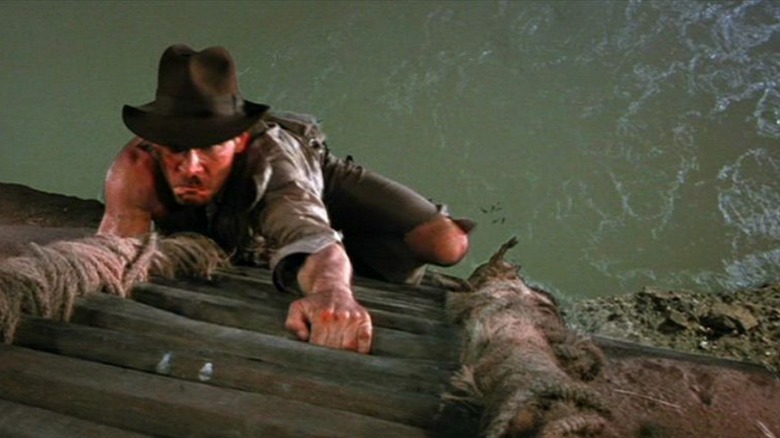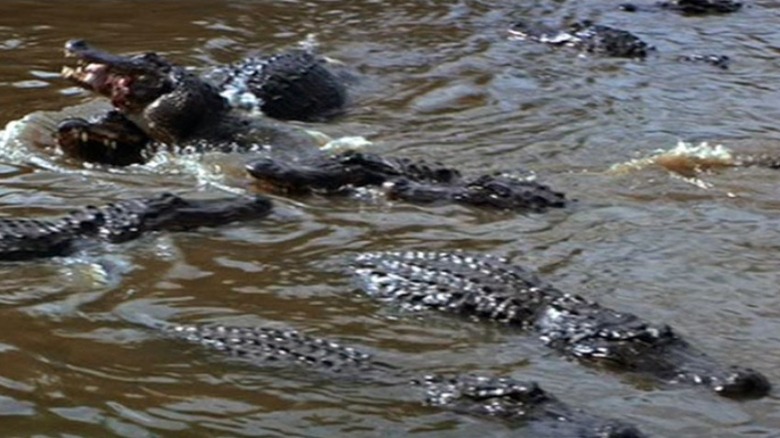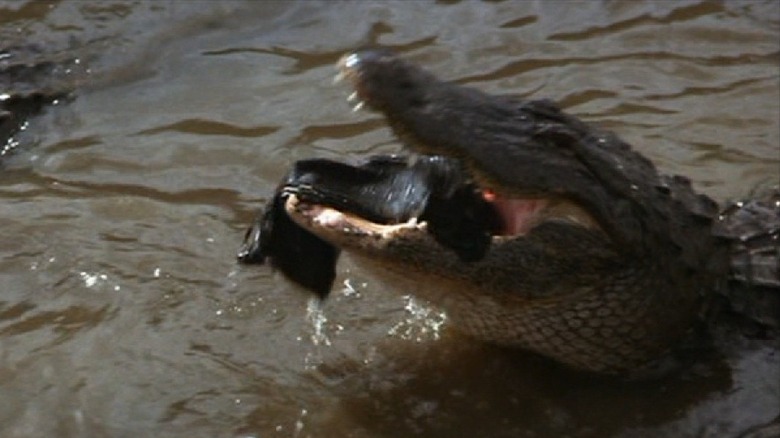Indiana Jones And The Temple Of Doom's Alligators Are Completely Inaccurate
During the knuckle-biting climax of Steven Spielberg's 1984 adventure film "Indiana Jones and the Temple of Doom," the title hero (Harrison Ford) finds himself on a rope bridge, suspended 100 feet over a canal in India. Evil henchmen with swords are approaching him from either side, aiming to grab the mystical Sankara stones from his satchel. In the ravine below, vicious crocodiles await, hoping to eat any poor souls who may fall. Indiana Jones, seeing no other way out, extracts a sword and threatens to cut the rope bridge. It's all very exciting.
One can forgive a lot of physical improbabilities in Spielberg's "Indiana Jones" movies, as they tend to be so enjoyable to watch. In the fantasy world of "Indiana Jones," we don't really care about Indy's bodily injuries. Continuity errors only become clear to the audience if Spielberg failed to engage us interestingly (see: "Indiana Jones and the Kingdom of the Crystal Skull") or if we've seen the film over 50 times, and small details begin to emerge from the central story.
As such, those who have seen "Temple of Doom" many, many times, might make note of the above-mentioned Indian crocodiles. Spielberg filmed the animals in mid-close-up, gathering in a group, snapping at the potential meals above. When someone does fall in the water, the crocodiles roll them around in the water, killing and eating them with haste. Indeed, one can see the crocodiles so clearly that any reptile expert will be able to tell you that ... they're not crocodiles.
In a video interview with Insider, Crocodile expert Frank Robb was asked to view a few notable crocodile and alligator scenes from famous movies and give his commentary. He had a lot of corrections for "Temple of Doom."
Those are alligators
A quick internet search reveals that India is home to three notable species of crocodile. There's the saltwater crocodile, which is the largest species of croc on the planet. There's the marsh-dwelling mugger crocodile, and there's the little, narrow-snouted critter called the gharial. None of these animals look like the ones seen in "Temple of Doom."
In the Insider video, Robb looks at scenes from films like "Crawl," "Lake Placid," and "'Crocodile' Dundee," pointing out the accuracies and mistakes. He even talks about the Loki alligator from the TV series "Loki." When he arrived at the clips from Spielberg's film, Robb noted that not only did they get the species wrong, but even alligators don't behave that way in the wild. He knew on site that these were zoo-dwelling, tame alligators on a movie set, not vicious killers in a distant ravine in India. He said:
"This is supposed to be in India, and they're showing American alligators in India. It would either be the Indian gharial or the saltwater crocodile you can find in some places in India as well. So they got the species wrong. They're not a communal eater whatsoever. Those animals are used to eating together. Alligators in the wild, you're not going to find sharing a meal. That does not happen. If they've got something and want to rip a piece of it off, that's how they'll take their prey and rip a piece off in order to have that right then and there."
There was, however, at least one detail the movie got right: alligators will indeed eat clothes.
Alligators and crocodiles can digest just about anything
Perhaps to spare the audience a great deal of gore, Spielberg elaborated on the alligators' viciousness by depicting them tearing apart their victims' clothes. I suppose that was more tasteful than having them pull apart actual bodies. It seems that our modern-day dinosaur friends are capable of eating and digesting clothes, and would have no issue swallowing up the bad guys whole. Robb said:
"Alligators and crocodiles can digest just about anything. They have something we call gastroliths in their stomachs. They're eating bones. If they can digest bones, then a piece of cloth is nothing. [...] If you factored in the way they were eating together, as soon as you saw that you'd immediately know that is not a wild situation. That's somewhere in a farm system or zoo."
Of course, most American audiences who aren't experts in Crocodilia wouldn't be able to tell the difference. Most of us just see big reptilian monsters ripping bad guys to shreds during the climax of a silly adventure movie.
Robb noted that even a film about crocodiles like "'Crocodile' Dundee" is not at all accurate, and stabbing a croc in the back will do nothing to hurt it. Meanwhile, movies like "The Big Short" which feature scenes of alligators hanging out in people's swimming pools are at least 90% accurate, as he, as a professional, has had to rescue alligators out of swimming pools on multiple occasions. He also wanted it known that alligators can open and shut their jaws with immense power, so if the movies ever told you that it's easy to merely hold an alligator's mouth shut, the movies are lying.


